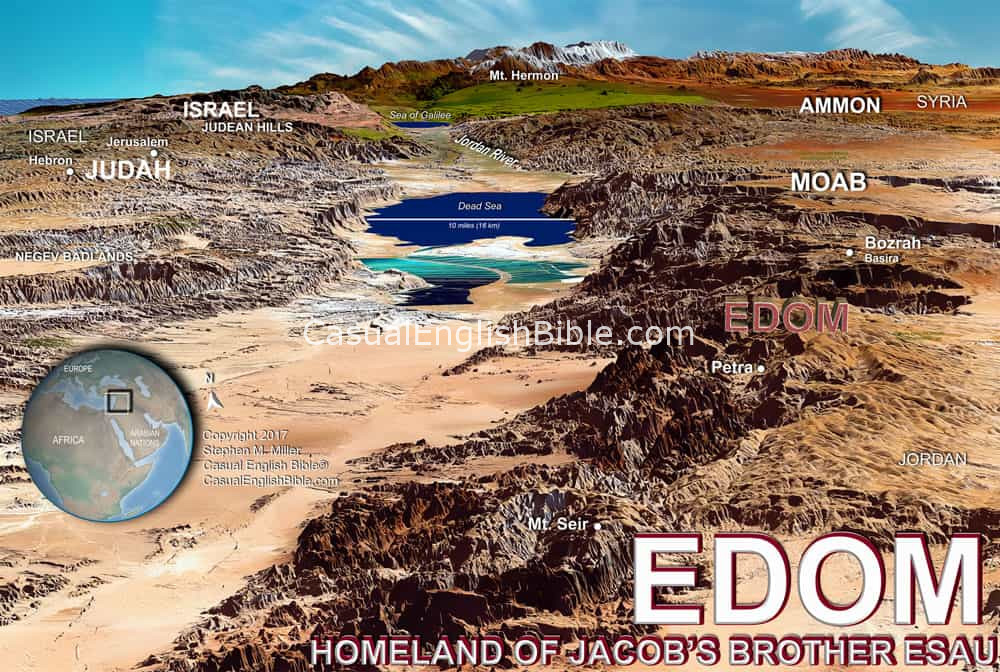Genesis 36
Esau’s family tree
Call him Red
1Here’s the story of the family of Esau, also known as Red. [1] 2Esau married two local women from the land of Canaan. [2] He married Adah, daughter of Elon the Hittite. [3] And he married Oholibamah, daughter of Anah and granddaughter of Zibeon the Hivite. [4] 3He also married his cousin: Basemath. She was Ishmael’s daughter and Nebaioth’s sister. 4All three women gave birth to Esau’s sons. Adah gave birth to Eliphaz. Basemath to Reuel. 5Oholibamah gave birth to three sons: Jeush, Jalam, and Korah. All five of Esau’s sons were born in the land of Canaan. 6Esau took everything he owned and moved out of Canaan. He took his wives, his sons and daughters, and everyone working for him, along with his livestock and everything of value that belonged to him. He moved a good distance from his brother Jacob. 7Land was the problem. There wasn’t enough good land in the area to sustain all the livestock of Jacob and Esau. 8So Esau moved to the hills of Seir. Esau is also known as Edom. 9Here’s the story of Esau’s descendants who lived in the hills of Seir. His people became known as the Edomites. 10Here’s the family tree that Esau planted, starting with his sons: Eliphaz, born to Esau’s wife Adah, and Reuel, born to Basemath. 11Eliphaz’s sons were Teman, Omar, Zepho, Gatam, and Kenaz. 12Eliphaz had another son by a slave wife, Timna: Amalek. These are the descendants of Esau’s wife Ada. 13Esau’s son with his wife Basemath was Reuel, who had four sons of his own: Nahath, Zerah, Shammah, and Mizzah. These are the descendants of Esau’s wife Basemath. 14Esau had three more sons with his wife Oholibamah, who was the daughter of Anah and granddaughter of Zibeon. They were Jeush, Jalam, and Korah. 15Some of Esau’s descendants rose to become leaders of their extended family, or clan. Here are the names of those clan leaders. Descendants of Esau’s oldest son, Eliphaz, served as leaders in the clans of Teman, Omar, Zepho, Kenaz, 16Korah, Gatam, and Amalek. These men, descended from Eliphaz, were clan leaders in the region of Edom. Every one of them descended from Esau’s wife Adah. 17Descendants of Esau’s son Reuel rose to lead the clans of Nahath, Zerah, Shammah, and Mizzah. These men, descended from Reuel, were clan leaders in the region of Edom. Every one of them descended from Esau’s wife Basemath. 18Descendants of Esau and his wife Oholibamah rose to become leaders of the clans of Jeush, Jalam, and Korah. These leaders descended from Esau’s wife Oholibamah, the daughter of Anah. 19So that’s the list of clans and their leaders. Each leader descended from Esau, nicknamed Red. [5]Tribes of Edom’s land
20Here are the sons of Seir the Horite, all of whom lived in the land of Edom: Lotan, Shobal, Zibeon, Anah, 21Dishon, Ezer, and Dishan. Each of these Horite men—sons of Seir in the land of Edom—led the clan named after them. 22Here are the sons of Lotan: Hori and Hemam. Lotan had a sister named Timna. 23Here are the sons of Shobal: Alvan, Manahath, Ebal, Shepho, and Onam. 24Here are the sons of Zibeon: Aiah along with Anah, who found the hot springs in the badlands when he was grazing the donkeys of his father, Zibeon. 25Here are the children of Anah: Dishon along with Oholibamah, the daughter of Anah. 26Here are the sons of Dishon: Hemdan, Eshban, Ithran, and Keran. 27Here are the sons of Ezer: Bilhan, Zaavan, and Akan. 28Here are the sons of Dishan: Uz and Aran. 29Here are the top leaders of the Horite families: Lotan, Shobal, Zibeon, Anah, 30Dishon, Ezer, and Dishan. The Horite clans are named after these clan leaders, all of whom lived in the land of Seir.Kings of Edom’s land
31Here are the kings who ruled Edom before Israel ever had a king. 32Bela, son of Beor, ruled Edom from his capital city of Dinhabah. 33When Bela died, Jobab the son of Zerah of Bozrah became king. 34When Jobab died, Husham from the region of Teman became king. 35When Husham died, Hadad became king. He ruled from his capital city of Avith. He’s the king who led his army in defeating Midianites in the region of Moab. 36When Hadad died, Samlah became king. He came from the city of Masrekah. 37When Samlah died, Shaul became king. He came from the city of Rehoboth along the Euphrates River. 38When Shaul died, Baal-hanan became king. He was the son of Achbor. 39When Baal-hanan the son of Achbor died, Hadar became king. He ruled from his capital city of Pau. He married Mehetabel, daughter of Matred, who was the daughter of Me-zahab. 40Here are the names of the clan leaders descended from Esau who lived in places named after them: Timna, Alvah, Jetheth, 41Oholibamah, Elah, Pinon, 42Kenaz, Teman, Mibzar, 43Magdiel, and Iram. So these are the clans—the extended families—descended from Esau, a man known also as Edom (Red), father of the Edomite people.Footnotes
Edom in Hebrew.
Israel and Palestinian territories.
Hittites were originally from Turkey.
Hivites lived in what is now Israel and Palestinian territories.
Edom in Hebrew.
Discussion Questions
- 1
The Genesis writer doesn’t let us get to know Esau very well. If you had to pick out the bullet points of his life—the most famous scenes or descriptions of him—what would some of them sound like?
- 2
There are questions over who Esau married, how many women he married, and whether or not some confused scribe mixed and matched the names somewhere along the way. But the one point made clear is that Esau married Canaanite women who “made life miserable for Isaac and Rebekah” (26:35). How do you think the women could have done that?
- 3
In Esau’s family tree, his most famous descendent is probably his grandson Amalek (36:12). Amalekites tried to stop Moses and the Jews from reaching the Promised Land, and King David later defeated them and annexed their region. Do you think that’s the point of the family tree? Or do you think there were other reasons the Genesis writer included it?
- 4
LIFE APPLICATION. If for some reason you got highlighted in your family tree, what do you think the writer would say was most notable about you? Of the people you know in your family, who would you say is most notable and why?







